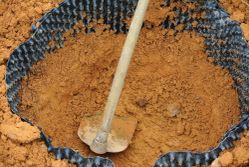4 FAQ About Root Barrier Installations

Trees bring ample curb appeal to properties, businesses, and homes, but knowing how to care for these plants can be complicated. Arborists may recommend root barrier installation to ensure a tree’s growth doesn’t impede the surrounding structures. The following guide provides a closer look at how root barriers can benefit your landscaping.
A Brief Guide to Root Barrier Installations
What is a root barrier?
These barriers act as walls and are placed in the soil around trees or structures to shield property against root damage. Problems can occur once a plant’s roots become overgrown, causing nearby pavement to crack or lift. Trees that are planted close to homes can also shift the building’s foundation as the roots grow and extend, leading to costly and extensive repairs. Underground pipes can also become clogged or burst due to vegetation invasion.
Which materials are used?
While chemical barriers can be used to quell overgrowth, physical installations are considered more eco-friendly because they redirect rather than exterminate the root system. They can steer growth away from a residence or business without inhibiting nearby plant life. Materials used for durable shields include high-density polyethylene, metal, and fiberglass.
Chemical tree root inhibitors use mesh-like material containing substances such as herbicide trifluralin to interrupt root growth. These can potentially carry toxic ingredients, so they are not recommended in areas like public parks.
Can you install them for existing trees?
 Although it’s best to have them installed before planting so you can direct roots from the beginning, root barrier installation can take place after the fact. Professionals may have to trim back roots depending on the amount of growth. They are trained to perform this task without harming the tree, so do not attempt this on your own.
Although it’s best to have them installed before planting so you can direct roots from the beginning, root barrier installation can take place after the fact. Professionals may have to trim back roots depending on the amount of growth. They are trained to perform this task without harming the tree, so do not attempt this on your own.
What takes place during root barrier installation?
Arborists begin by measuring the diameter of the trunk and multiplying that number by three. The length of the root barrier is taken into consideration, as well. The professionals will divide that figure by the width of its panels so they know how many are needed. They also measure how far away from the tree they need to dig, which is usually about three times the trunk’s diameter.
Once all measurements are complete, arborists will dig a trench about 2 to 3 feet deep and 3 to 4 inches wide. The barrier’s panels are then inserted so that they stick up about 2 inches above the ground. Dirt and water are then combined to create compact soil in the area.
When you need to remove an overgrowth of roots or take preventative measures, turn to Nature’s Tree Removal of Houston in Katy or Conroe, TX. This locally owned and operated company offers root barrier installations, dead and decaying tree removal, trimming, and stump grinding services to homeowners and businesses throughout Harris County. They are also licensed, bonded, and insured. Call (713) 824-9036 to schedule a free estimate, or visit their website for more information.
About the Business
Have a question? Ask the experts!
Send your question

